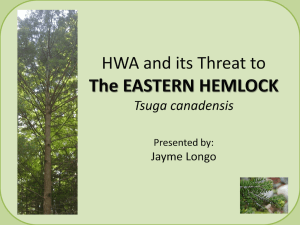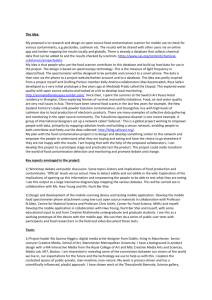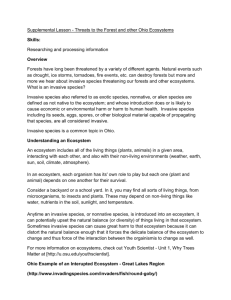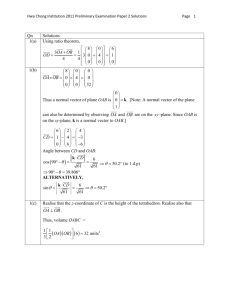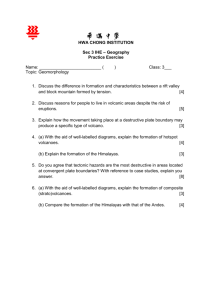draft - Northeastern Area
advertisement
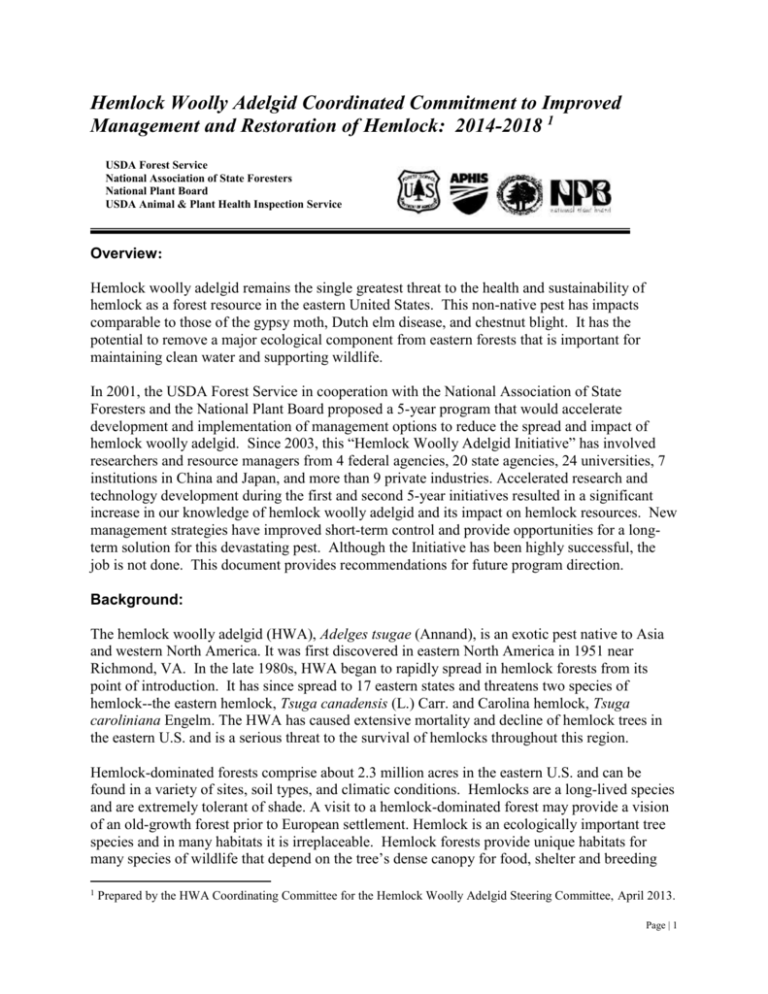
Hemlock Woolly Adelgid Coordinated Commitment to Improved Management and Restoration of Hemlock: 2014-2018 1 USDA Forest Service National Association of State Foresters National Plant Board USDA Animal & Plant Health Inspection Service Overview: Hemlock woolly adelgid remains the single greatest threat to the health and sustainability of hemlock as a forest resource in the eastern United States. This non-native pest has impacts comparable to those of the gypsy moth, Dutch elm disease, and chestnut blight. It has the potential to remove a major ecological component from eastern forests that is important for maintaining clean water and supporting wildlife. In 2001, the USDA Forest Service in cooperation with the National Association of State Foresters and the National Plant Board proposed a 5-year program that would accelerate development and implementation of management options to reduce the spread and impact of hemlock woolly adelgid. Since 2003, this “Hemlock Woolly Adelgid Initiative” has involved researchers and resource managers from 4 federal agencies, 20 state agencies, 24 universities, 7 institutions in China and Japan, and more than 9 private industries. Accelerated research and technology development during the first and second 5-year initiatives resulted in a significant increase in our knowledge of hemlock woolly adelgid and its impact on hemlock resources. New management strategies have improved short-term control and provide opportunities for a longterm solution for this devastating pest. Although the Initiative has been highly successful, the job is not done. This document provides recommendations for future program direction. Background: The hemlock woolly adelgid (HWA), Adelges tsugae (Annand), is an exotic pest native to Asia and western North America. It was first discovered in eastern North America in 1951 near Richmond, VA. In the late 1980s, HWA began to rapidly spread in hemlock forests from its point of introduction. It has since spread to 17 eastern states and threatens two species of hemlock--the eastern hemlock, Tsuga canadensis (L.) Carr. and Carolina hemlock, Tsuga caroliniana Engelm. The HWA has caused extensive mortality and decline of hemlock trees in the eastern U.S. and is a serious threat to the survival of hemlocks throughout this region. Hemlock-dominated forests comprise about 2.3 million acres in the eastern U.S. and can be found in a variety of sites, soil types, and climatic conditions. Hemlocks are a long-lived species and are extremely tolerant of shade. A visit to a hemlock-dominated forest may provide a vision of an old-growth forest prior to European settlement. Hemlock is an ecologically important tree species and in many habitats it is irreplaceable. Hemlock forests provide unique habitats for many species of wildlife that depend on the tree’s dense canopy for food, shelter and breeding 1 Prepared by the HWA Coordinating Committee for the Hemlock Woolly Adelgid Steering Committee, April 2013. Page | 1 sites. Hemlock is commonly associated with riparian areas and has been shown to play an important role in buffering stream water temperatures and preventing erosion on steep banks. It is a preferred nesting and denning habitat for a significant number of wildlife species. As a forest resource, hemlock’s value to fish and wildlife and its contribution to the ecology of important riparian areas likely exceed its timber value. Aesthetically, hemlocks are highly valued in recreational areas and urban landscapes. In the urban environment, hemlock is one of the most common species planted by homeowners. Key Issues: Continued Spread. HWA currently infests nearly one half of the native range of hemlock in the East. It can be found from southeastern Maine to northeastern Georgia and as far west as eastern Tennessee (Figure 1). The HWA continues to spread at an average rate of 12.5 km per year. HWA has also been found in isolated locations in Vermont, Ohio, and Michigan as the result of infested nursery stock being transported from the generally infested area. Forestry and agriculture officials in those three states have undertaken eradication efforts and Maine, New Hampshire, Vermont, Ohio, Wisconsin and Michigan have implemented quarantines. Reducing the rate of artificial spread and overall impact of HWA have become the primary management goals. Figure 1. County-Level Distribution of Hemlock Woolly Adelgid Resource Impacts. Areas of extensive tree mortality and decline are found throughout the infested region, but the impacts have been most severe in Virginia, Pennsylvania, West Virginia, New Jersey, Connecticut and, more recently, North Carolina and Tennessee. The rate of spread and magnitude of impact have thus far been lower in the insect’s more northerly range; this is Page | 2 likely the result of severe winter temperatures that periodically cause a reduction in adelgid numbers. Conversely, HWA expansion in the southern range has been much more rapid and the impacts to the southern hemlock resource are expected to be devastating. Harvesting of hemlock is proceeding at a rapid pace in infested states as landowners attempt to salvage value from threatened trees. In general, the impacts of HWA on hemlock forests and ecosystems are expected to intensify throughout the range of eastern hemlock. Without intervention, hemlock is at risk of becoming an inconsequential component of forest ecosystems and urban landscapes throughout its range. Key accomplishments over the last 10 years: The predatory beetle Laricobius nigrinus (native to the Pacific Northwest) has been successfully established in 13 states and can now be collected in sufficient numbers in several areas for redistribution to other HWA-infested forests in the East. More than 2.5 million Sasajiscymnus tsugae predatory beetles (native to Japan) have been reared and released throughout the East and this species is now established in many areas. Several additional natural enemies have been identified and are progressing toward release against HWA. They include 2 species of Scymnus lady beetles (one from China and one from the Pacific Northwest), Leucopis flies from the Pacific Northwest, and a more voracious Laricobius species from Japan. A web-based HWA predator database was created to track all predator release locations and monitor establishment results. An interactive web-based HWA bibliography database was created and linked to the HWA website to provide rapid access to all published HWA and hemlock related literature citations and abstracts. Prepared and published a comprehensive book on the HWA biological control program titled “Implementation and Status of Biological Control of the Hemlock Woolly Adelgid”. Two systemic insecticides (imidacloprid and dinotefuran) are now registered and available for use in the forest environment. These insecticides are currently used to protect high-value hemlock forests throughout the East. Resistant hemlock genotypes, either of putative susceptible species identified from devastated landscapes or through breeding with resistant species, are under evaluation and development. Molecular genetics technology has been used to pinpoint the origin of HWA and identify several distinct populations of HWA worldwide. The science of molecular genetics has been invaluable for the biological control program by providing an efficient means to identify morphologically similar species of Laricobius and Leucopis predators and as a tool to recognize, monitor and manage the hybridization between closely-related Laricobius species. Improved assessments of impacts have been developed through classical economics as well as remote sensing. Several survey methods for assessing HWA infestations were developed which can be tailored to various objectives. Page | 3 Information transfer has greatly improved access to available information: a website dedicated to HWA (http://na.fs.fed.us/fhp/hwa/) is in place that provides both the public and researchers with up-to-date information, four symposia were held that provided a forum for managers and researchers alike to find out what is being done over the full range of topics, and proceedings from the symposia that serve as quick references were published. State and federal resource managers can now actively manage their hemlock resources and protect high-value stands from HWA. Recommendations for Future Program Direction: The knowledge base needed to develop and implement an effective HWA management program was increased significantly during the 2003-2013 period of this initiative. Progress in managing HWA has been made, but additional investments in research and technology development are needed to advance long-term management strategies, particularly in the areas of biological control, host resistance and insecticidal management. By 2016, we expect a much reduced need for research and methods development in the area of classical biological control as we will have completed the necessary evaluations and initiated the establishment of all of the known summer and winter HWA predators believed necessary for long-term management. Efforts beyond this timeframe will be more operational in nature and consist primarily of rearing, field collecting, augmentative and classical release and evaluation of existing natural enemies as HWA continues to expand its range. Further work in the areas of host resistance and silvicultural management will likely need to continue into the next decade as these areas of research and development progress. Evaluation of new insecticides and/or application methods as they become available should continue as newer classes of insecticides and application methods suitable for the forest environment become available. We anticipate the existing methods development work related to the aerial application of the fungal pathogen Lecanicillium muscarium will be minimal as we expect to be fully operational by 2016. Continued research in the areas of HWA biology and ecology should continue, particularly in the investigations of HWA symbiotes. Recommendations for 2014-2018 activities are summarized in Appendix A and include the following: Biological Control: Although two predatory beetles have been established for biological control of HWA, these are spreading slowly. Additional species and better methods are needed to accelerate spread and to increase populations to levels that can suppress and maintain HWA below damaging levels. Three additional beetles have been approved for release and better methods of mass producing them need to be developed. Several candidates in quarantine in the western U. S. need further evaluation and development of rearing methodology. Priorities include: 1. Continue quarantine screening of newly discovered predators and begin field evaluations of promising candidates. Page | 4 2. Phase out mass rearing of Laricobius nigrinus in the laboratory to allow rearing of new predators as they become available. 3. Utilize field collections of L. nigrinus from western North America and field insectaries in the East and continue to redistribute and augment existing release areas as needed. 4. As new predators become available, phase out lab mass rearing and release of S. tsugae in the southern range. 5. Begin mass rearing and field release of L. osakensis in areas where L. nigrinus has failed to establish and begin field evaluations to assess establishment and efficacy at reducing HWA populations. 6. Begin to develop mass rearing methods for Leucopis flies and study their impacts on HWA in the East. 7. Begin mass rearing of Scymnus coniferarum and evaluate its establishment and impact on HWA in the southern range. 8. Begin mass rearing, release and evaluation of S. camptodromus in the northern range and upper elevations in the south. Insecticidal Management: Soil and stem applications to manage HWA on individual, highvalue trees or groups of trees has been shown to be effective but the cost is high and alternatives for environmentally sensitive areas are needed. Aerial application options are needed to treat large or otherwise non-accessible hemlock stands. Protection of high-value hemlock trees and groups of trees should continue until natural enemies become established and provide control of HWA. 1. Continue evaluating new insecticide formulations and application methods to efficiently and effectively treat hemlock stands. 2. Continue aerial field trials of fungal pathogens, including Lecanicillium muscarium (formerly Verticillium lecanii) using newly developed formulation technology and evaluate efficacy and non-target impacts. 3. Continue studies on optimal dosage and uptake of systemic insecticides. 4. Continue studies on movement and persistence of imidacloprid in soils. 5. Evaluate the efficacy and application of dinotefuran (Safari®) as an alternative systemic insecticide suitable for management of elongate hemlock scale (EHS). 6. Evaluate the use of both chemical and biological control strategies in the same landscape to evaluate compatibility and efficacy in controlling HWA populations. Silvicultural Management: In the face of changing forests, land managers need better analytical tools and experimentally evaluated protocols for developing and exploring silvicultural options. 1. Continue efforts to evaluate the effect of pre-infestation thinning of mixed-hardwood stands on vulnerability of hemlock to HWA infestation. 2. Continue improvements to the Forest Vegetation Simulator (FVS) to include an HWA hazard rating “addfile” extension through the integration of newly acquired knowledge about the biology of the HWA and its impact on stand structure. This tool will continue to allow forest managers to visualize forested systems after impact by HWA, and under various silvicultural treatments. Page | 5 Host Resistance: There are three approaches to increasing the resistance of hemlocks in the eastern U.S. to HWA. One is to incorporate the natural resistance of Asian or Western U.S. species (which have co-evolved with HWA) into the native eastern U.S. species through breeding programs. Another is to discover hemlocks with higher resistance among existing growing stocks and propagate these. A third approach would be to identify environmental influence on resistance. 1. Continue development and evaluation of hybrid T. caroliniana and T. chinensis, including generation of F2 and backcross populations. 2. Determine whether the above hybrids will back-cross with T. caroliniana. 3. Determine the nature of incompatibility between T. canadensis and other Tsuga species and the means to overcome this incompatibility so that hybrids can be created with T. canadensis. 4. Make out plantings of the most promising hybrid crosses over the natural range of eastern hemlocks in order to verify their growth characteristics in a variety of environments. 5. Identify naturally occurring specimens of T. canadensis which have survived in generally infested areas and explore the genetic basis of this resistance. 6. Identify the role environmental factors play in mediating the tolerance of hemlock to HWA on the landscape, and investigate how landscape heterogeneity can be leveraged to help maintain hemlock in the landscape. 7. Conserve the gene pool of eastern and Carolina hemlock until biological control and/or other means are available to reduce HWA below damaging levels. 8. Continue to study the impacts of HWA feeding on hemlock physiology to be able to recognize resistance mechanisms. Biology and Ecology: Recent breakthroughs in molecular techniques have helped explain the source of HWA in eastern North America. Important questions about the genetics of HWA populations, its hosts and its natural enemies remain. Additional information is needed on how climate and extreme maximum and minimum temperatures affect HWA population dynamics. Knowledge of the feeding behavior and nutritional requirements of HWA would help in resistance studies and insecticidal management. With the identification of the source population, the climatic preferences of HWA can be estimated. Once identified, the key climatic factors that facilitate or limit HWA growth can be used to identify areas with similar conditions, from which biological control agents may be identified. Once identified, analysis of the similarities of requirements between the adelgid and the biological control can help managers tailor the use of specific biological controls to regions of the landscape. These analyses are based on global climate data sets in combination with custom-built population models. In concert with other systems such as the Forest Vegetation Simulator (FVS), these tools may assist land managers with selecting appropriate species, timing, conditioning, and distribution of released biological control agents. This work is being integrated with a landscape-wide study of the relationships between the HWA and environment, to assist with identifying those areas most at risk for infestation. Page | 6 1. Complete global database on environmental parameters for HWA. 2. Elucidate the population genetic structure of HWA at a sufficiently fine level and link this to life history and host interactions to assist development of management options. 3. Identify interactions between landscape characteristics (such as climate) and biotic factors, including natural enemies. 4. Define HWA feeding behavior and nutritional requirements. 5. Determine how HWA interacts with hemlock trees to compromise them and cause tree decline/death. 6. Develop DNA barcodes to identify interceptions of adelgids and support biosecurity. 7. Identify threats to biodiversity and ecosystem services associated with hemlock. 8. Determine if HWA symbiotes may produce a toxin and influence the adelgid’s ability to overcome hemlock defenses. Impact Assessments: Methods to evaluate impacts to hemlock resources are currently available using Landsat imagery and hyperspectral remote sensing technologies. The economic damage to property values in residential communities have been assessed in the northern range of HWA but may not be applicable to the loss of hemlocks in communities in the southern range. Furthermore, the economic impacts on recreation and nearby communities have not been addressed. 1. Conduct comparable community-based economic assessment in the southern Appalachians. 2. Assess the potential economic impacts to recreational areas such as the Great Smoky National Park and Delaware Water Gap National Recreation Area. Survey and Monitoring: Sufficient methods are now available for survey and monitoring purposes and no further methods development is needed. 1. Continue annual regional assessments to better define newly infested areas by using existing survey methods. 2. Continue financial assistance to states conducting surveys and reporting results. Information Transfer: Maintaining an updated USDA Forest Service HWA website and publishing new information related to management of HWA has been an effective way of reaching resource managers, private land owners, and the general public. Publishing HWA newsletters and conducting periodic HWA symposia with published proceedings has also proven effective at distributing new information and developing collaboration among researchers and resource managers. 1. Continue support in maintaining the HWA website with new information as it becomes available. 2. Continue publishing periodic newsletters and conducting HWA symposia in alternating years. 3. Post on the HWA website the current status of the biological control effort. Page | 7 4. Link the HWA Predator database to the HWA website in a manner that allows the public to monitor progress. Federal Role: The hemlock woolly adelgid is a regional pest problem currently impacting 17 states and threatening four additional states in the eastern United States. This insect has long-term effects on forest resources that can potentially affect a broad sector of the public. A management initiative coordinated by a federal agency will improve efficiency and effectiveness. The USDA Forest Service has instituted the HWA Initiative, in part, at the request of the National Association of State Foresters and the National Plant Board. Program Components: Research & Technology Development. Enhanced efforts are needed to continue and accelerate the development of pest management technology. Priorities are to increase effectiveness of biological controls and insecticides and provide more options for restoring damaged forests. Classical biological control using predators and pathogens is the most viable long-term and sustainable management strategy for mitigating HWA impacts in our forests. Research and development of biological control strategies need to be continued and expanded. Developing efficient, effective, and ecologically sound tactics for both suppression and eradication are needed for stand-level treatments. Current chemical insecticide formulations and application methods are an effective tool to mitigate HWA damage on accessible individual trees and as an eradication tool, but other methods are needed to treat large or otherwise inaccessible hemlock stands. A better understanding of HWA biology is essential for the development of effective pest management strategies. Critical biological factors include the importance and significance of seasonal mortality, causes and limitations of dispersal, and effects of other pests and host interactions. The eastern hemlock species are very susceptible to injury from HWA, whereas Asian hemlock species (native range of HWA) and western hemlocks show more tolerance to HWA. Research is needed to identify host resistance mechanisms and to develop resistant hemlock hybrids and cultivars. It is important to expand existing management guidelines for the harvest and restoration of severely damaged forests. Success will be measured by the extent of implementation and use of newly developed tools and techniques. Management. This component has two priority areas. The first priority is continuing the implementation of available HWA control tactics by increasing emphasis and technical and financial assistance through the use of State & Private Forestry cost-share programs. Immediate actions include getting available biological control agents into the field and widely distributed. Additional natural enemies will be released as they become available. A major part of this activity is the mass rearing of predators for release on infested lands. Other actions include improving the effectiveness of eradication tactics and implementing newly developed management tools to assist forest managers, forest health specialists, and homeowners. Acres treated and reducing hemlock mortality are measures of success. Page | 8 The second priority is reducing the artificial spread of HWA to uninfested areas. This requires the establishment and maintenance of an accurate database of infested locations, development and implementation of better systems to track movements of hemlock products between states, and establishment and administration of uniform state regulatory policies. Increased efforts to monitor and detect HWA must be deployed to meet these objectives. Success will be measured by reducing the number of accidental introductions of HWA to uninfested locales. Information Transfer. There is an increasing need to make the public aware of HWA and to disseminate newly developed technology to manage this pest. Early detection of HWA infestations before they become generally established is critical to successful eradication of infestations and slowing the overall spread of HWA. A public that is educated and informed about HWA enables state regulatory agencies to respond more effectively to isolated infestations. This approach was recently demonstrated in Michigan, New Hampshire, Maine and Vermont where media campaigns that followed the discovery of HWA-infested nursery stock resulted in additional infestations being identified by the public. Early recognition of HWA can provide landowners with an opportunity to control HWA populations on valued trees before damage occurs. As new tools, strategies, and treatment options are developed, this information and technology must be transferred and demonstrated to land managers, forest health specialists, and the general public. A measure of success is the interest and demand for information products. USDA Forest Service Focus: The USDA Forest Service is actively involved in addressing the HWA problem. State and Private Forestry (S&PF), through both the Cooperative and Federal Forest Health Management programs, provides technical and financial support for HWA detection, eradication, suppression, and technology development efforts. S&PF is well positioned to serve as an information clearinghouse and to coordinate multi-state operations through cooperating state forestry and state agriculture organizations. Forest Service Research & Development, through the Northern and Southern Research Stations, is investigating key research problems related to the management of HWA. The USDA Forest Service will continue to make significant investments in research and development of technologies to mitigate HWA impacts. State & Private Forestry annually supports projects through existing forest health management and technology development programs. The Northern and Southern Research Stations support HWA research and development activities through competitively awarded agreements conducted by staff scientists and researchers from universities and state experiment stations to provide improved management of HWA. Joint requests for proposals (R&D and S&PF) have been a vital tool for addressing the research needs. These projects are limited in scope, but have already produced significant information and leveraged outside funds. Leadership & Oversight: With the support of the National Association of State Foresters and the National Plant Board, the USDA Forest Service has formed a HWA Steering Committee to provide direction and guidance for future activities and projects addressing the HWA problem. The Steering Committee is composed of senior managers from the Forest Service’s State & Page | 9 Private Forestry and Research Branches, APHIS- PPQ, and representatives from the Northeastern Association of State Foresters and the National Plant Board. The Forest Service has assigned technical specialists from both Research & Development and State & Private Forestry to coordinate this initiative. This assignment includes developing detailed action plans and preparing periodic reports on activities and accomplishments for interested constituents. Governance of the HWA Initiative is further described and appended to this document (see Appendix B). The approval, by the responsible Forest Service officials, for implementation of the 2014-2018 strategic plan is appended to this document (see Appendix C). Page | 10 APPENDIX A: Summary of 2014-2018 HWA Initiative Strategic Plan Priorities Research & Development Biological Control: Develop biological controls (invertebrate predators and pathogens) that are effective and environmentally safe. Includes: foreign exploration of new, potential biological control agents; pre-release evaluation of biology, host range, and possible effects on non-target organisms; development of release protocols; and field trials to verify effectiveness. Insecticidal Management: Develop more efficient and ecologically sound insecticide treatments, with a focus on treatment of hemlock forests. Utilize aerial application technology and fungal pathogens and evaluate efficacy, non-target effects, and persistence in the environment. Survey & Monitoring: Utilize existing survey technologies to effectively detect and monitor adelgid populations and their impacts on hemlock stands, landscapes, and regional levels. Silvicultural Options: Develop best management practices for forest managers in advance of HWA by evaluating various management prescriptions designed to improve tree vigor and collect and analyze data from infested areas that used various harvest and management strategies. Host Resistance/Vulnerability: Continue methods development to recognize and predict tree and stand vulnerability; initiate development of HWA-resistant hybrids or cultivars. Includes crossbreeding tests, analysis of the influence of site factors and host plant chemistry on tree vulnerability. Biology & Interactions: Acquire knowledge of HWA biology and interactions with other pests that is necessary to develop appropriate management options. Includes information on HWA survival factors, phenology, genetics, and impacts on hemlock health, and interactions with other pests. Management Biological Control: Mass rear and release available predators including technology development of mass rearing and release techniques. Evaluate the effectiveness of predator release and impacts on HWA populations. Insecticidal Management: Refine and update application technology; pilot test new methods; update recommendations to users; where appropriate, provide technical and financial assistance in suppression and eradication control programs. Survey & Monitoring: Enhance detection and delineation of new and current infestations; evaluate biological and insecticidal treatment efficacy; identify areas at high risk; maintain and update an accessible database of infested areas in support of state agencies regulating the movement of infested hemlock products to non-infested areas. Impacts/Economics: Expand assessment of economic impacts at landscape and regional scales affected by HWA. At a regional level, quantify impacts to the hemlock resource and assess effects on associated fauna and flora, and water quality. Page | 11 Restoration/Silviculture: Provide technical and financial assistance in the restoration of severely impacted habitats. Identify, disseminate, and demonstrate silvicultural alternatives for landowners. Information Transfer Education/Awareness: Develop and implement programs to increase awareness in uninfested and newly infested areas; provide programs to transfer latest management techniques. Publications/Website: publish new and update existing information on HWA when needed; upgrade and maintain a dedicated website. Page | 12 APPENDIX B: Governance of the Hemlock Woolly Adelgid Initiative A. Background / History A Hemlock Woolly Adelgid Working Group was first formed in the early 1990’s in response to the discovery of hemlock woolly adelgid (HWA) infesting northeastern states and causing significant mortally of hemlocks particularly in New Jersey and Connecticut. This working group consisted of federal, state and university scientists and forest health specialists who all shared an interest in developing and implementing a management solution for HWA. The Working Group first met in the early 1990's in Virginia and then again in the mid-1990's in Connecticut to discuss the growing HWA threat and to develop a recommended course of action. They identified 10 components of an Integrated Pest Management strategy targeting needed research and technology development (e.g. biological control, chemical control, survey methods, host resistance, etc.). A Technical Committee was organized for each of the 10 components and each was charged with identifying their specific research needs. As progress was made, most of the technical committees have since disbanded as we completed various components of the plan (we now have survey methods, registered chemicals for forest applications, dedicated HWA website, etc.). A Coordinating Committee was organized to manage the technical committees and pull together both a strategic plan and an annual plan of work based on funding made available by the USDA Forest Service Washington Office (WO). Once the HWA Initiative was funded, a Steering Committee was formed to provide direction and oversight for the Initiative. B. Current Organizational Structure and Responsibilities: Steering Committee Chairman: Provides leadership to Steering Committee in the oversight of the HWA Initiative direction and accomplishments. The Chairman (one of the Steering Committee members from the US Forest Service, Forest Health Protection) is appointed by consensus of Steering Committee for an indefinite term (subject to periodic review). Current Chair: National Entomologist, Forest Health Protection, WO Steering Committee members: Consortium of federal and state agency officials that review program direction, priorities and solicit external support for the Initiative. Members are appointed by their leadership for an indefinite term (subject to regular review and occasional rotation as may meet Regional leadership or initiative needs). Additional Steering Committee members may be appointed as needs may dictate. Roles and Responsibilities • Overall oversight (meet annually in January) • Assess direction, progress and accomplishments • Review current and identify new priorities • Review recommended allocations and approve an annual plan of work from the coordinating committee • Promote interagency communication at the upper management levels Current Committee Members: Forest Health Assistant Directors, Program Managers, and Research Project Leaders: Page | 13 • • • • • • • • Director, Forest Health Protection, Southern Region Assistant Director Forest Health and Economics, Northeastern Area Assistant Director, Northern Research Station Assistant Director, Southern Research Station National Entomologist, Forest Health Protection, Washington Office State Forest Health Program Managers representing the National Association of State Foresters (NAASF and SGSF) State Plant Pest Regulatory Official representing the National Plant Board National Biological Control Program Manager, USDA APHIS, PPQ Program Coordinators: Interact with Steering Committee Chairman on HWA Initiative direction and accomplishments and provides leadership to Coordinating Committee. Program Coordinators are FHP specialists appointed by the Steering Committee for an indefinite term (subject to Regional/home unit leadership approval and occasional rotation as may meet Regional/home unit leadership or initiative needs). Current Program Coordinators: • NA FHP representative • R8 FHP representative Coordinating Committee: The primary mission of the HWA Coordinating Committee is to coordinate the development of management tools as quickly as possible and to transfer the technology to federal and nonfederal land management agencies and the public. The Coordinating Committee evolved from the original HWA Working Group. Members were appointed by the HWA Steering Committee for an indefinite term (subject to Regional/home unit leadership approval and periodic review). Roles and Responsibilities • Develop and present to Steering Committee an annual plan of work • Review and recommend priorities to Steering Committee • Serve as a clearinghouse for HWA information • Prepare briefs, newsletters, and other information products as needed or requested by the Steering Committee • Provide updates for HWA website • Manage the technical committees. Current Coordinating Committee Members: • Northeastern Area (FHP): FHP entomologists • Southern Region (FHP): FHP entomologist(s) • Washington Office (FHTET): Entomologist • Northern Research Station: Research scientist • Southern Research Station: Research scientist Technical Committees: Members consist of forest health specialists, practitioners, and research scientists from federal, state and private industries involved with HWA management and research related activities. The committees are called on as needed by the Coordinating Committee for input on identifying management needs and potential technology development solutions, and assist in technical review of project proposals. Technical Committee members are recommended by the Coordinating Committee (for appointment by the Steering Committee) based on their expertise and the needs of the particular Technical Committee. 2 Role and Responsibilities • Provide technical support for the HWA Initiative • Assist Coordinating Committee in identifying current needs related to the development or improvement on effective management tools • Participate in technical review of proposals. • Established and retired by Coordinating Committee as needed Technical committee members include: FS-FHP and R&D, State forestry agencies and agricultural departments, universities and NGO’s. Currently (as of 2014) there are two active committees: biological control, and the host resistance and gene conservation technical committees. C. Typical Calendar for the HWA Initiative Implementation: Activity Program development Assessment of research and technology needs Web-site management Newsletter Press releases, briefing papers, and accomplishment reports Annual Work Plan drafted Regional/Area Review of draft work plan* Program review, discussion and approval of the annual plan of work (APW)** Occurrence As needed As needed As needed Responsible Official Coordinating Committee Coordinating Committee Technical Committees Program Coordinators Coordinating Committee As needed Program Coordinators October - December Program Coordinators December Individual Steering Committee Members Annual meeting in January Steering Committee Annual summary in September *Need determined by individual Steering Committee members; ** Approval of the annual plan of work subject to the concurrence of the national FHP Director. D. Decision Making The HWA Initiative is a national effort organized and primarily funded by Forest Health Protection. Steering Committee members are delegated by their respective leadership with authority to make recommendations for the annual plan of work and the funding allocations. However, the overall concurrence with the annual plan of work and funding allocations is reserved for the USDA Forest Service, National Director, Forest Health Protection in concurrence with the Northeastern Area Director, Northern and Southern Research Station Directors and the Region 8 Regional Forester or their designees. Steering Committee members are expected to brief and seek feedback from their leadership and relevant stakeholders in advance of the annual Steering Committee meeting. E. Annual Project Selection During the course of the year, priority areas are identified by the Coordinating Committee based on an assessment of accomplishments in the “Coordinated Commitment” (formerly the FY 2000 Needs Assessment), and emerging or continuing issues (i.e. better lab rearing methods, need for better impact assessments, survey methods). The Technical and Coordinating Committees 3 identify projects and potential project recipients that would address the needs and priorities. Cooperating NRS or SRS research scientists take the lead when funding is available and proposed technology development projects are linked to ongoing or proposed FS research activities, otherwise FHP takes the lead. An FHP methods or bio-control development project recipient is typically a university scientist familiar with and has the appropriate background and experience needed to successfully accomplish the project. Prior to 2010, an RFP process was used to identify and select project recipients. Since then however, the vast majority of tech development projects have been continuing projects. The annual HWA Bio-control meeting (January) identifies further priorities. Pre-proposals for these activities are shared with the Steering Committee in January. The Steering Committee concurs (or not) and based on the amount of funding available and the origin (FHP, R&D, APHIS) of the money, the Coordinating Committee recommends who would pay for each of the selected proposals. With Steering Committee concurrence that information is sent to the Washington Office, where final approval of allocation levels is made. At this point project selection is considered “complete”. HWA Initiative Program Coordinators then work with Project recipients to finalize grant narratives and grant packages. During this stage, the Coordinating and Technical Committees are engaged to provide technical review. Once a desired management tool (i.e. survey methods, chemical treatment methods) is developed and the technology sufficiently transferred and operational, the Steering Committee provides no further oversight. Selection and implementation of projects to apply those tools then becomes a regional decision based on local needs and available funds. F. Monitoring and Evaluation The Steering Committee is responsible for monitoring and evaluation of the initiative and providing regular reports to leadership and stakeholders. Individual grants funded through the initiative are assigned monitors, whose responsibilities are similar to those of monitors for noninitiative grants. At the grant level - monitoring and evaluation takes place on an ongoing basis over the life of the grant. From the initiative standpoint, monitoring and evaluation occurs primarily at the annual Steering Committee meeting (in the form of discussion of progress, effectiveness, lessons learned, etc.), but also at the biennial HWA Stakeholders meeting (a large state-of-the-knowledge meeting). Guidance to the Steering Committee is provided both by the US Forest Service FHP Washington Office (represented on the Steering Committee), as needed or requested, and through the engagement of individual Steering Committee members with their local leadership. As noted above, Steering Committee members are expected to brief and seek feedback from their leadership and relevant stakeholders in advance of the annual Steering Committee meeting. G. Funding The allocation for the HWA Initiative is established annually by the national director of the Forest Health Protection program following consultation with the regional and area forest health protection program directors (as per the practice with other Forest Health priorities, in establishing the national FHP allocation) the Northeastern Area Director and the R8 Regional Forester. The annual allocation for the HWA Initiative reflects a balance between the needs of the Initiative, and the needs of other national forest health priorities. HWA Initiative funds are disbursed through the federal forest health (SPFH) and cooperative forest health (SPCH) budget line items. SPCH funds are used to support HWA activities on nonfederal lands while SPFH 4 funds are reserved for funding HWA activities on federal lands. SPFH funding is the preferred source for supporting technology development and methods improvement work that benefits all cooperators; however SPCH funds may be used to support production rearing of HWA predators for annual release by all cooperators. Available initiative funds are allocated from the WO to NA and R8 based on different factors, including where and by whom individual projects will be led. 5 Appendix C: Approval of the 2014-2018 HWA Initiative Strategic Plan by the Responsible Forest Service Officials IN WITNESS WHEREOF, the parties hereto have executed this agreement and approval of the 2014-2018 HWA Initiative Strategic Plan as of the last written date below. This plan may be implemented immediately. <signed> 12/12/13 Tony L. Ferguson Date Area Director, Northeastern Area State & Private Forestry <signed> 11/21/13 Liz Agpaoa Date Regional Forester, Southern Region <signed> 12/12/13 Michael T. Rains Date Station Director, Northern Research Station and Forest Products Laboratory <signed> 11/30/13 Robert L. Doudrick Date Station Director, Southern Research Station 6
